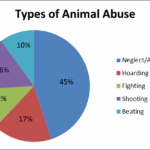In the United States, animal cruelty laws serve as both a shield and a sword for our voiceless companions, shaping the ethical landscape in which we govern our interactions with fellow creatures. From the verdant landscapes of California to the expansive plains of Texas, and the subtropical hinterlands of Florida, each state has carved out its own peculiar niche in the realm of animal protection. This guide explores the intricate frameworks surrounding animal cruelty laws in these three states, juxtaposing their unique appeals and philosophical underpinnings.
Florida, often painted as a mosaic of sunny beaches and vibrant wetlands, possesses a legal framework that reflects its diverse ecological inhabitants. The state’s animal cruelty statute, codified in Chapter 828 of the Florida Statutes, outlines a broad interpretation of cruelty, encompassing acts such as neglect, abandonment, and willful infliction of physical or mental pain. This legislation acts as a bulwark against cavalier attitudes toward animals, recognizing their intrinsic value in society.
The penalties in Florida range significantly depending on the severity of the offense. For instance, intentional acts of cruelty can lead to felony charges, whereas negligent actions may fall into misdemeanor territory. An intriguing dimension of Florida’s approach is the inclusion of veterinary professionals in the decision-making process when distress signals arise. The law mandates that veterinarians report suspicions of animal abuse, creating a collaborative network that protects animals from cruelty.
Meanwhile, Texas, the Lone Star state, showcases a different ethos in its animal welfare statutes. The Texas Penal Code Section 42.09 and 42.092 provides a detailed framework addressing cruelty and neglect. Here, the laws are stark; an individual may face criminal charges if they intentionally, knowingly, or recklessly engage in conduct that causes unjustifiable pain or suffering to an animal. The statute delineates specific acts that are prohibited, such as torturing, mutilating, or killing an animal without a lawful justification, thereby fostering a culture of respect and responsibility for animal welfare.
In Texas, the state has notably authorized the creation of animal cruelty task forces, enhancing the enforcement and investigation capabilities. One cannot overlook the power of this initiative—it’s a concerted effort that not only aims to eradicate animal cruelty but also educates the public about humane treatment and the responsibilities of pet ownership. This community involvement cultivates a paradigm shift, bridging the chasm that often exists between the human and animal worlds.
California, with its legislative avant-garde spirit, stands as a beacon in the movement towards animal welfare. The state’s extensive animal cruelty laws encompass a broad range of protections. The California Penal Code Section 597 through 597.7 details what constitutes cruelty, addressing both acts of commission and omission. Here, the law explicitly forbids abandonment, neglect, and infliction of cruelty, and significantly, it also addresses the plight of animals used in entertainment and research. The stringent regulations reflect California’s commitment to not merely curtail cruelty but also prevent exploitation.
In a unique development, California has pushed boundaries with measures such as Proposition 12, which aims to regulate humane farming practices. Its progressive stance positions California at the forefront of the animal rights movement, inspiring other states to reconsider their legislative approaches. This landscape constantly evolves, invigorating discussions about the ethical treatment of animals within various commercial contexts.
When comparing these three states, Florida, Texas, and California, one might view them as distinct strokes on a vast canvas of animal welfare—a chiaroscuro of laws that seeks to illuminate the dark corners of animal cruelty. Florida’s collaborative approach, with its emphasis on veterinary involvement, encourages a united front against abuse. Texas utilizes a robust community framework to enhance enforcement, thus transforming public perception into powerful advocacy. On the other hand, California’s legislative innovation pushes the envelope further, encouraging a reexamination of animal rights that extends beyond mere mental and physical welfare to encompass broader ethical considerations.
This state-by-state guide underscores not merely the differences but the underlying currents that unify and propel the animal welfare movement across the nation. The prominent voices in each state articulate their own version of justice for animals, reminding us that, while our laws may differ, the moral imperative remains unchanged: to protect those who cannot speak for themselves. The tapestry of animal cruelty laws thus unfolds as a reflection of humanity’s evolving conscience, a testament to our capacity for empathy, compassion, and responsibility.
As we look ahead, it becomes paramount to foster collaboration among states, sharing best practices and innovative strategies to further refine and enhance animal welfare legislation. With every incremental shift in policy and each communal effort against cruelty, we knit a more compassionate world for our animal counterparts—transforming the cautionary tales of the past into beacons of hope for the future. This imperative calls for unwavering commitment from citizens, legislators, and advocates alike, as we strive toward cultivating a society that champions the dignity and well-being of all living beings.



